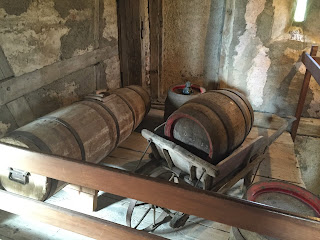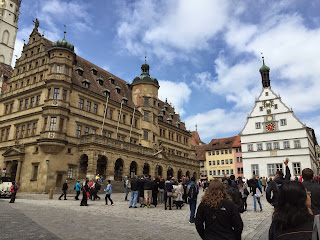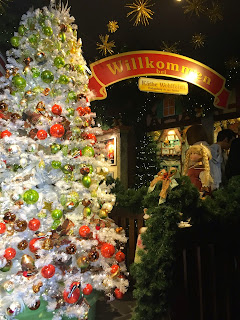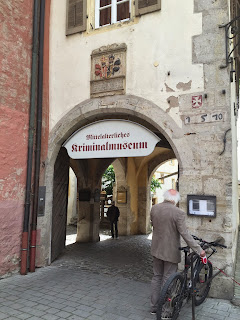17 May 2015 (Sunday) - The Romantic Road, Harburg and Rothenburg ob de Tauber (on the Tauber River). The weather forecast predicted that it would be a rainy sunday. Hence, it was a blessing that I had decided earlier to join the bus tour operated by the Gray Line Agency. Our tour guide had a deep and smooth voice which was remarkably pleasant to the ears and on the bus he gave a running commentary of the sights and scenery throughout our journey on the romantic road.
In Medieval times, it was a trade route connecting the Central Germany to the South. Subsequently, after the World War II, when many parts of Germany were damaged by the aerial bombings and most cities were filled with wreckage and debris, the US soldiers noted that the countryside of Bavaria, mainly agricultural and rural lands were unspoilt by the war. Thereafter, many travellers started taking this route and it became famously known as the Romantic Road.
Our first stop was Harburg, a pleasant town with narrow cobblestone streets and a historic bridge, but the most famous attraction is Harburg Castle, the picturesque castle on a cliff above the village.
For 900 years the castle has been owned by the royal family Oettingen-Wallerstein and it grew from a fortress into a pleasant residential palace. Michael Jackson tried unsuccessfully to buy Burg Harburg. The family Oettingen-Wallerstein has also two other castles along the Romantic Road: Wallerstein and Baldern.
Along the outer wall, there were many wall fortifications, such as holes for archers to shoot their arrows, places for rifles to be launched and areas to obtain water, which was a crucial resource especially when the royal family were seeking refuge within the castle with enemies guarding outside the castle gates.
Archers to launch their arrows
Lookout areas
Gunman to shoot their rifles through these coconut holes
Drawing water from such crevices in the wall
In the past, most citizens, armies and rulers may be illiterate. Hence, shields were painted with logos so that one would know to whom he has pledged his allegiance and distinguish between enemies and friends. The designs would often carry the meaning of the name of the ruler they serve, for example a flag with a knight on a black horse could mean that the army belonged to Sir Blackknight.
Symbol of the Ruling Harburg Royal Family
Notice that the windows in the above photos are painted in the same design?
When the outer walls were breached, there was still the inner walls within the castles. Here you would note from the picture below that the walls were far thicker than those of the outer wall.
Thick walls
Toilet within the inner walls
A handcuffing mechanism for punishment
The well was first used to store water. However, when it was noted that there was not much water to be drawn, it was transformed into a dungeon pit where prisoners were thrown into.
According to our guide, Germany aims to completely phase out nuclear power by the end of 2020. Hence, the government gives out grants to companies / homes to encourage them to explore alternative energy resources.
Windmills and Solar Panels
Our final stop and main attraction of the day was Rothenburg ob der Tauber (i.e. Red Fortress above the Tauber River). It is Germany's best preserved wall town.
Legends said that Rothenburg was not destroyed by wars because the town brewed good wine. Warlords who came to conquer the town were invited to drink as much of the good wine as they could till they were too drunk to fight.

Rothenburg Town Hall
Glockenspiel which chimes every hour featuring
warlords getting drunk on Rothenburg's good wine
warlords getting drunk on Rothenburg's good wine
St James (St. Jakob) Lutheran Church
In Rothenburg, you can celebrate Christmas for 365 days throughout the year in Kathe Wohlfahrt's Weihnachtsdorf (i.e. White Night Village). Kathe became a millionaire for selling Christmas items all year-round. The ornamental shop has an excellent little German Christmas Museum upstairs. Its unique collection is much more than a ploy to get you to spend more money. You will marvel at the tree decorations through the ages, Christmas-tree stands, mini-trees sent in boxes to WWI soldiers at the front, early Advent calendars, and old-time Christmas cards, all thoughtfully arranged and described!
The US Assistant Secretary of War knew about the historic importance and beauty of Rothenburg and offered to spare the city of Rothenburg from shelling and bombing if the Germans agree not to defend it. Hence, the local military commander gave up the town, ignoring the order of Hitler for all towns to fight to the end and thereby saving it from total destruction by artillery.
Town walls encircling the city and stretching 2.5km
Fancy a ride around the town?
The Medieval Crime and Punishment Museum (Kriminalmuseum) is full of examples of torture equipment and not for the faint-hearted. Of course I didn't dare to enter... But I was game for the Night Watchman's tour which runs nightly. Sadly as I had to leave early to catch my bus I couldn't try it...
The Church of St. John is one of the few Roman Catholic Churches in the mainly Protestant city of Rothensburg. In around 1400, the church was completely remodelled in the late Gothic style, giving its current plain appearance.
You will be spoilt for choice with the endless flavours and sizes of Schneeballs, but my suggestion is to go for the mini balls as they are crispier and taste sweeter. The larger balls tend to taste too floury / doughy towards the end.
My favourite mini schneeballs!
Soon it was time to leave beautiful Rothenburg and return home. Here's a parting shot from the romantic ride back home!











































































Wonderful post! Harburg to Rothenburg ob de Tauber Romantic Route Germany looks beautiful. I will be visiting there next month to celebrate my Birthday. I might use your blog to explore the hidden gems of Germany.
ReplyDelete